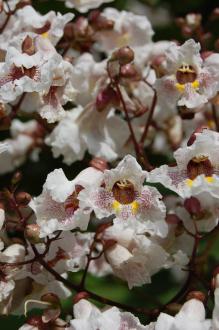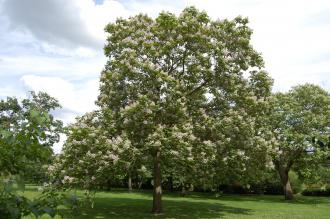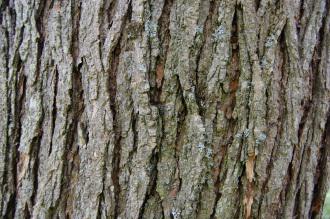
Catalpa x erubescens ‘Purpurea’ Flower (28/07/2012, Kew Gardens, London)
Position: Full sun to partial shade
Flowering period: Summer
Soil: Moist, well drained
Eventual Height: 10m
Eventual Spread: 10m
Hardiness: 5a – 9b
Family: Bignoniaceae
Catalpa x erubescens ‘Purpurea’ is a small deciduous tree with a spreading habit. Its mid green leaves are opposite, cordate with entire margins, up to 40cm long and 20cm broad. In spring its leaves emerge dark brown to purple. Its bark is brown/ gray and becomes ridged with age. Its fragrant bell shaped flowers are white with yellow stripes and purple spots inside, appear in panicles of up to 30 and are up to 4cm long and 5cm broad. Its fruit is a hanging legume like pod, round in cross section and may achieve a length of up to 40cm long. These usually remain on the tree during the winter months.
Catalpa x erubescens ‘Purpurea’, commonly known as Purple Catalpa or the Indian Bean Tree. The species, Catalpa x erubescens, is a hybrid between Catalpa bignonioides and Catalpa ovata. This hybrid is noted for being resistant to honey fungus.

Catalpa x erubescens ‘Purpurea’ (28/07/2012, Kew Gardens, London)
The etymological root of the binomial name Catalpa is believed to be a mispronunciation of the name of the Catawba Native Americans. Erubescens is derived from the Latin erubesco meaning ‘to blush’, in reference to its spring leaves. Purpurea is from the Latin meaning ‘purple’, once again in reference to its leaves.
The landscape architect may find Catalpa x erubescens ‘Purpurea’ useful as a flowering specimen tree. It is tolerant of urban pollution. It prefers a sheltered position. Care should be taken when locating this tree as the seed pods and seeds fall off this tree during the winter and spring.
Ecologically, Catalpa x erubescens ‘Purpurea’ is attractive to pollinating insects.

Catalpa x erubescens ‘Purpurea’ Bark (28/07/2012, Kew Gardens, London)
The Royal Horticultural Society has given Catalpa x erubescens ‘Purpurea’ their prestigious Award of Garden Merit in 1993.
Catalpa x erubescens ‘Purpurea’ prefers moist, fertile, well-drained soils. It tolerates most pH of soil.
Catalpa x erubescens ‘Purpurea’ requires little maintenance. This tree may be pruned hard in March or April.

